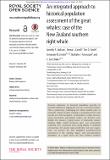Files in this item
An integrated approach to historical population assessment of the great whales : case of the New Zealand southern right whale
Item metadata
| dc.contributor.author | Jackson, Jennifer | |
| dc.contributor.author | Carroll, Emma Louise | |
| dc.contributor.author | Smith, Tim | |
| dc.contributor.author | Zerbini, Alexandre | |
| dc.contributor.author | Patenaude, Nathalie | |
| dc.contributor.author | Baker, C. Scott | |
| dc.date.accessioned | 2016-03-17T09:30:06Z | |
| dc.date.available | 2016-03-17T09:30:06Z | |
| dc.date.issued | 2016-03 | |
| dc.identifier | 241567722 | |
| dc.identifier | 886421cd-9cec-4cc5-b0ba-d62b2b86639c | |
| dc.identifier | 84962174281 | |
| dc.identifier | 000377969200019 | |
| dc.identifier.citation | Jackson , J , Carroll , E L , Smith , T , Zerbini , A , Patenaude , N & Baker , C S 2016 , ' An integrated approach to historical population assessment of the great whales : case of the New Zealand southern right whale ' , Royal Society Open Science , vol. 3 , 150669 . https://doi.org/10.1098/rsos.150669 | en |
| dc.identifier.issn | 2054-5703 | |
| dc.identifier.uri | https://hdl.handle.net/10023/8429 | |
| dc.description | E.C. was supported by a fellowship from the Tertiary Education Commission. | en |
| dc.description.abstract | Accurate estimation of historical abundance provides an essential baseline for judging the recovery of the great whales. This is particularly challenging for whales hunted prior to twentieth century modern whaling, as population-level catch records are often incomplete. Assessments of whale recovery using pre-modern exploitation indices are therefore rare, despite the intensive, global nature of nineteenth century whaling. Right whales (Eubalaena spp.) were particularly exploited: slow swimmers with strong fidelity to sheltered calving bays, the species made predictable and easy targets. Here, we present the first integrated population-level assessment of the whaling impact and pre-exploitation abundance of a right whale, the New Zealand southern right whale (E. australis). In this assessment, we use a Bayesian population dynamics model integrating multiple data sources: nineteenth century catches, genetic constraints on bottleneck size and individual sightings histories informing abundance and trend. Different catch allocation scenarios are explored to account for uncertainty in the population's offshore distribution. From a pre-exploitation abundance of 28 800–47 100 whales, nineteenth century hunting reduced the population to approximately 30–40 mature females between 1914 and 1926. Today, it stands at less than 12% of pre-exploitation abundance. Despite the challenges of reconstructing historical catches and population boundaries, conservation efforts of historically exploited species benefit from targets for ecological restoration. | |
| dc.format.extent | 16 | |
| dc.format.extent | 736945 | |
| dc.language.iso | eng | |
| dc.relation.ispartof | Royal Society Open Science | en |
| dc.subject | Whaling | en |
| dc.subject | Historical abundance | en |
| dc.subject | Southern right whale | en |
| dc.subject | Bottleneck | en |
| dc.subject | Recovery | en |
| dc.subject | GC Oceanography | en |
| dc.subject | GE Environmental Sciences | en |
| dc.subject | DAS | en |
| dc.subject.lcc | GC | en |
| dc.subject.lcc | GE | en |
| dc.title | An integrated approach to historical population assessment of the great whales : case of the New Zealand southern right whale | en |
| dc.type | Journal article | en |
| dc.contributor.institution | University of St Andrews. School of Biology | en |
| dc.contributor.institution | University of St Andrews. Sea Mammal Research Unit | en |
| dc.identifier.doi | 10.1098/rsos.150669 | |
| dc.description.status | Peer reviewed | en |
This item appears in the following Collection(s)
Items in the St Andrews Research Repository are protected by copyright, with all rights reserved, unless otherwise indicated.

